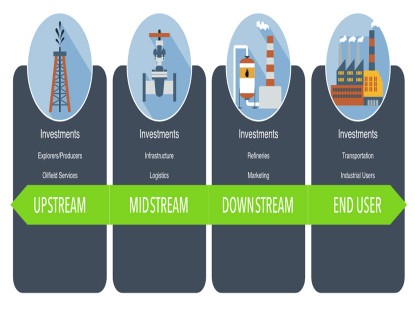Midstream Companies Offering a Compelling Entry Point
Midstream companies continued their strong performance in 2025. The following commentary summarizes the long-term appeal of midstream companies in a volatile market year.
-
 Ben Cook, CFAPortfolio Manager
Ben Cook, CFAPortfolio Manager -
 L. Joshua Wein, CAIAPortfolio Manager
L. Joshua Wein, CAIAPortfolio Manager
Key Takeaways
» In 2025, midstream subsector equities continued to outperform other energy subsectors as well as the broader market.
» U.S. natural gas consumption is expected to rise due to increased LNG exports, the onshoring of manufacturing, and higher power demand driven by AI.
» We expect midstream cash payouts will continue to rise over the next several years, and as a result, the sector will likely remain appealing to incomeoriented investors.
» Master limited partnerships continue to trade at a discount to their long-term average.
Would you please discuss the performance of the midstream sub-sector over the first half of 2025?
Thus far in 2025, midstream subsector equities continued to outperform other energy subsectors as well as the broader market. Sector appeal continues to benefit from a combination of favorable corporate governance drivers, namely improved capital discipline and attractive shareholder returns. In addition, the sector continues to benefit from positive underlying upstream fundamentals, as volumes of U.S. crude oil, natural gas and natural gas liquids continue to grow. Going forward, we expect that the rising global demand for U.S. energy will continue to propel infrastructure expansion needs ultimately providing growth tailwinds for midstream companies within our investable universe.
Would you please discuss the growth drivers of natural gas demand and how midstream companies benefit?
According to the U.S. Energy Information Administration (EIA), U.S. natural gas consumption is expected to rise approximately 8% between 2024 and 2030, principally on three key drivers: increased liquefied natural gas (LNG) export, increased onshoring of industrial activities consuming natural gas, as well as increased power demand needed to serve the computing requirements associated with artificial intelligence (AI). LNG export volume is expected to rise by approximately 9.5 billion cubic feet per day (bcf/d), or 9%, from year-end 2024 demand levels by year end 2030, while AI computing power related demand could rise by about 9 bcf/d or 8.5% during that same period. Midstream companies operating natural gas transportation infrastructure are anticipated to be primary beneficiaries of this growth opportunity.
Given geopolitical concerns, how does the price of oil impact midstream companies in the short run?
On a short-term basis, crude oil price variability has relatively little impact on the midstream sector financial performance. While some midstream companies may have minimal directional exposure to crude oil pricing, most midstream sector companies operating crude oil infrastructure assets generate revenue and cash flow by assessing fees to shipping customers for various services, including gathering, transportation and storage of crude oil volumes. Consequently, volumetric trends rather than price tend to have more influence on the cash generation and corresponding financial condition of the midstream companies in our portfolio.
Would you please discuss the attractiveness of midstream companies’ dividend growth and coverage as the Federal Reserve pauses on rate cuts? How would the resumption of Fed rates cuts impact this dynamic?
We expect that midstream cash payouts to investors will continue to rise over the next several years, and as a result, we expect that the sector will maintain and potentially broaden its appeal to income-oriented investors facing a flat-to-declining yield environment. According to Wells Fargo Equity Research, on average, sector payout looks to be growing at 5% per year over the next five years. Importantly, projected payout levels are generously covered by company cash flow levels. Again, according to Wells Fargo equity research, sector dividend coverage, or cash available for distribution divided by cash payout is roughly 1.9x, or said differently for every $1 in cash payout, companies within the sector are generating roughly $1.90 in cash to cover that payout, suggesting very little risk to cash payout. Should the Fed resume reducing short term interest rates, the sector should benefit given the relative attractiveness of its rising yield profile.
What is the current valuation of midstream MLPs compared to their historical average?
Master limited partnerships (MLPs) continue to trade at a discount to their long-term average. As of May 31, 2025, the EV to estimated 2025 EBITDA of the MLP sub-group was 8.6x relative to the 10-year average of 9.7x on the same basis. For midstream C-Corps, the group is currently trading around 10.2x, slightly below their 10-year average of 11.0x. Combined with higher-quality balance sheets, consistent distribution growth, and higher distribution coverage ratios, we believe midstream companies offer a compelling entry point.
With continued market fluctuations and uncertainty, why do midstream companies remain attractive?
We believe midstream companies are relatively insulated from broader market fluctuation and commodity volatility given the nature of operations and their revenue and cash flow generation. Most midstream companies generate revenues and cash flow based on fees assessed to shipper customers. Because those fees are generally stable, broader market fluctuations and commodity volatility have very little impact on company cash flow. As previoulsy mentioned, underlying volumetric trends tend to influence company cash generation. While the outlook for U.S. lower 48 crude oil volume growth has become more muted recently due to the contraction in oil directed drilling activity, the industry is still projected to generate modest crude oil volume growth in 2025 and 2026.
By comparison, the growth outlook for U.S. lower 48 natural gas remains robust. Companies operating along the natural gas value chain stand to benefit from volume growth tailwinds that should persist into the next decade.
- In this article:
- Energy
- Midstream Fund
You might also like
-
 Investment Idea
Investment IdeaDefining the Energy "Value Chain"
 Ben Cook, CFAPortfolio ManagerRead the Investment Idea
Ben Cook, CFAPortfolio ManagerRead the Investment IdeaEnergy is a large and complex sector. The sector’s broad sub-industries can be divided into a “value chain,” each segment of which has different characteristics and offers different investment opportunities.
-
 Portfolio Perspective
Portfolio Perspective
Energy Transition FundEnergy - Attractively Valued Sector with Higher Free Cash Flow Yields
 L. Joshua Wein, CAIAPortfolio Manager
L. Joshua Wein, CAIAPortfolio Manager Ben Cook, CFAPortfolio ManagerRead the Commentary
Ben Cook, CFAPortfolio ManagerRead the CommentaryIn the following commentary, Portfolio Manager Ben Cook and Josh Wein discuss the Fund’s disciplined process throughout the volatility driven by tariff uncertainty and geopolitical developments.
-
 Portfolio Perspective
Portfolio Perspective
Gas Utility FundNatural Gas: Essential to Reliable Power
 Ryan C. Kelley, CFAChief Investment Officer and Portfolio Manager
Ryan C. Kelley, CFAChief Investment Officer and Portfolio Manager L. Joshua Wein, CAIAPortfolio ManagerRead the Commentary
L. Joshua Wein, CAIAPortfolio ManagerRead the CommentaryUtilities have delivered strong returns in 2025, fueled by demand trends, earnings growth and their defensive nature, positioning natural gas utilities as a compelling opportunity amid market uncertainty.
